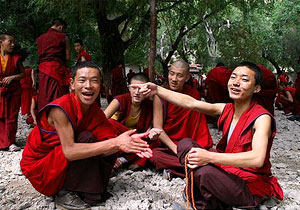Sera Monastery

Sera Monastery is situated about 5 km northern outskirt of Lhasa. It was built in 1419 by a disciple of Tsongkhapa. Sera had housed about 5000 monks in its glorious time, but now there are only about 800 in residence.
The monastery, covering 114,946 square meters (28 acres), mainly consists of the Coqen Hall, Tsokchen Hall (Great Assembly Hall), Zhacangs (colleges) and Kamcun (dormitory). A profusion of Tibetan Buddhism heritage can be found in chapels of these halls like scriptures written in gold powder, fine statues, gold and silver wares and intricate murals. Sera opens from 9:00am-06:30pm while some chapels are close at 04:00pm.
Apart from the similar temple part you are likely to see in other Lhasa temples, the thing that makes different and highlights Drepung is the monks' debating. The debating is for the young monks to deeper understand their learned Buddhism knowledge and advance their Buddhist degree. The debating topics widely cover from the Buddhism scriptures to history, literature and science. The debaters always debate in pair (some also debate in a group) and in Tibetan. The standing monks pop up the question and the cross-legged sitting monk answer. The one that cannot come up with the new question or right answer loses. Actions and emotions fill through the debating process: clapping the hands, rolling the prayer beads, punching the palm, and raising their voice pitch, etc. The debating takes place from 03:00pm bto05:00pm, Mon.-Sat. The garden entrance usually opens minutes ahead and better to use the time to seize an advantaged view position. Photograph is allowed during the debating.
The rear hill of monastery is worthy of a walk with its spiritual sites and scenery. The thangka unfolding ceremony site in Shoton Festival (in Tibetan late June and early July) can offer you an overlook of the monastery and a view of the city. And there are giant marnyi stones over the hill creatively engraved and painted by the worshippers and monks to express their belief and wishes. The colorful painting images always relate to Buddhist scriptures and Buddha portraits. Beside, the holy celestial burial site of the Tibetan is also located there. Since it is not accessible for the tourists, all you can see is the white heaven ladders painted on the mountainside, which are believed to be the path leading the dead to heaven.